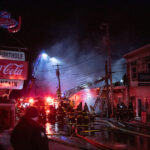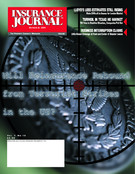Lloyd’s of London, the world’s oldest and most visible insurer, finally released its projected loss figures from the disastrous events of Sept. 11. According to the calculations from over 100 syndicates, net loss exposure will be around £1.3 billion ($1.91 billion.), the largest single loss in Lloyd’s 300-plus year history.
Due to Lloyds’ unique structure, calculating the potential losses it faced required an incredible amount of time and energy. As an insurance market—not an insurance company—Lloyd’s is comprised of 108 separate underwriting syndicates in four major categories: Marine, Non-Marine, Motor (Auto Insurance) and Aviation; there are also “composite” syndicates that write in two or more areas.
“In fact, the boundaries are increasingly blurred, and it’s becoming harder to analyze our business along these lines,” said Lloyd’s spokesman Adrian Beeby. He indicated that a syndicate, providing that it’s properly capitalized and adheres to the business plan it has submitted to Lloyd’s regulators, “can write anything it wants.” This includes both primary and reinsurance.
Syndicate 2791, which began operations in January with a capacity of $209.5 million, is a good example. It’s managed by Managing Agency Partners, and its lines of business include “property insurance and reinsurance—casualty insurance and reinsurance,” (D&O, E&O, EPL and medical malpractice).” It also writes policies in auto, accident and health, marine, political risks and space and entertainment risks. That’s more lines than a lot of companies have.
When a disaster of the magnitude that struck the U.S. occurs, it becomes very complicated to determine the extent of the exposures. “Not only are you dealing with 108 syndicates,” said Beeby, “but also with the solvency of 890 corporations and approximately 2800 individuals.” Although he declined to break down the loss estimates into primary and secondary loss categories, Beeby indicated that “reinsurance coverage was a major part of our analysis.” He’s fairly certain, however, that having taken the time to properly calculate its exposure, Lloyd’s definitive loss figures will not vary a great deal from the $1.91 billion.
The exact percentage of Lloyd’s business composed of reinsurance is not certain. According to its Glossary, it’s more than half of its total business. Beeby said it’s more like 40 percent. Whatever the actual figure, it’s a large portion of the risks that pass through Lloyd’s. In the year 2000, net written premiums from reinsurance totaled almost $4 billion.
Beeby pointed out that “according to Standard & Poor’s 2001 edition of Global Reinsurance Highlights, the top five reinsurers by net premium in 2000 were: 1) Munich Re, $10.6 billion; 2) Swiss Re, $5.2 billion; 3) Lloyd’s, $3.9 billion; 4) Allianz AG, $3.7 billion; and 5) General Re, $3.2 billion.”
Different ratings may use different criteria. The Reinsurance Association of America puts Lloyd’s in seventh place, using the same net written premium figure as S&P.
Ultimately, Lloyd’s syndicates cover risks, and those risks can be practically anything. The same syndicate may write primary coverage, surplus lines, treaty reinsurance, facultative reinsurance and retrocessional coverage in a number of areas, which explains why it took more time for Lloyd’s to calculate its loss exposures. Lloyd’s is addressing the problem. One of the goals of its market reform program is to have a single underwriter responsible for each risk.
Other insurance companies can neatly compartmentalize their business. Munich Re writes as much primary coverage as it does reinsurance, but it does it through carefully denominated subsidiaries like Ergo. Lloyd’s can’t do this.
Ironically, on the same day as the disasters, London’s Financial Times published a series of articles on the reinsurance industry, which generally contained some encouraging news. While warning that results were deteriorating, it noted that the decrease in capacity was putting upward pressure on rates. Lloyd’s, which hasn’t made an overall profit since 1996, was expected to benefit from this trend, and to at least break even this year and return to profitability in 2002. Those predictions no longer have any validity after Sept. 11.
Most analysts actually breathed a sigh of relief at Lloyds’ estimates. While paying the losses will clearly be a heavy blow to the capital of Lloyd’s syndicates and will probably require additional contributions to its Central Fund, it’s nonetheless seen as manageable. Lloyd’s Chairman Sax Riley has continually assured the international community since the day of the attacks that with $27 billion in assets, Lloyd’s can manage the loss exposures.
When it finally released its loss estimates, Riley commented: “While a figure of this size will have a significant impact on the Lloyd’s market, the market’s strong capital base will absorb this. The size of our asset base, the spread of the losses and the resilience of the reinsurance programs in place are important in coming to this conclusion.”
Reinsurance consultant Paul Walther, who heads Reinsurance Directions, agreed that reinsurance will be a key element in managing the losses, but expressed two concerns. “They [Lloyd’s] may not have enough cover. Size matters, and some of the smaller and more moderate-sized syndicates may not have enough, especially the ones with multi-lines of business.” He also worried that the “spiral effect” will reconcentrate losses in syndicates that had ceded coverage.
While the future will determine whether the reinsurance cover of Lloyd’s syndicates is adequate or not, Beeby disputes the implication that Lloyd’s will suffer from the spiral effect. “We had a problem in 1988-92 when asbestos hit, large losses were concentrated in small spirals, but we learned a big lesson.” Lloyd’s adopted new regulations to eliminate the problem of its syndicates ceding coverage to other syndicates, and ultimately getting the same loss exposure ceded back to them.
“By regulation, a certain amount of risks must be reinsured outside of the Lloyd’s market,” Beeby said. “In addition, Lloyd’s Regulatory Directorate monitors [reinsurance placement] individually on a transaction-by-transaction basis.” He estimated that more than “90 percent of our reinsurance risks are placed outside Lloyd’s with reinsurance companies rated ‘A’ or better.”
Following the catastrophe, the rating services have been reviewing the financial condition of literally hundreds of insurers. It was almost inevitable, given its large exposures, that Lloyd’s would be one of the first to be downgraded, and it was. S&P announced on Sept. 20 that it had downgraded Lloyd’s financial strength rating from “A+” to “A,” its sixth highest grade. On Sept. 24, A.M. Best followed suit, lowering the Lloyd’s market rating from “A” to “A-.”
The comments A.M. Best made are revealing. It anticipates that there will have to be “significant voluntary contributions from trade investors, many of whom are also very exposed to this event from their non-Lloyd’s exposures.” It also expects a higher “risk of unrecoverable reinsurance, and is worried about the discrepancy between the public pronouncements of loss estimates, and the amounts the insurers have said they are exposed to.”
“Moreover,” Best’s report continued, “the Lloyd’s market is a specialist in several of the lines of business most impacted. This includes Business Interruption, where losses are currently particularly hard to quantify but where the loss potential is clearly significant.”
Beeby explained that part of the problem stems from Lloyds’ U.S. activities. While it reinsures a number of U.S. insurers’ risks, it also reinsures European companies, who cover U.S. risks, but the operations are different. The coverage placed in the U.S. affects the trust funds Lloyd’s has on deposit. The New York Insurance Department administers them, and significant decreases in their amounts have to be replenished, which is not the case with Lloyd’s European exposures. “There’s a fundamental difference between the two, and so how the reinsurance is structured is a vital factor,” Beeby said.
Best and other analysts believe that Lloyd’s Central Fund, which contains around $300 million at present, may be called upon to take up losses from syndicates whose own reserves are insufficient. The fund is the “third link in Lloyd’s chain of security.” It pays claims if the individual syndicate reserves and those of its members, corporate or individual, are unable to.
It in turn is backed up by a policy Lloyd’s negotiated in 1999, which provides for £350 million ($515 million) of cover over five years with an aggregate limit of £500 million ($735 million). Swiss Re, Employers Re, The St. Paul, Hannover Re, XL and Chubb are the underwriters. They are also some of the insurers with the largest exposure estimates from the Sept. 11 disasters.
Lloyds’ real need in the coming months, and probably years, will be to rebuild its capital. As Riley stated, with $27 billion in assets it’s hard to believe that the U.S. disaster will be the end of Lloyd’s, but its future activities could be significantly curtailed by a lack of capacity. Even if that reduction results in higher premiums, neither Lloyd’s nor any other insurer can profit from it if they don’t have sufficient capital to underwrite policies.
Reinsurance Directions’ Walther said he is “fearful for Lloyd’s future.” He thinks that a lot of the corporate capital which has flowed into Lloyd’s over the last five or six years may leave.
Insurers need to replace their own capital reserves first before increasing any commitments they may make to Lloyd’s syndicates. In addition, they may look for higher returns elsewhere than Lloyd’s or the reinsurance market. Surviving this crisis will severely test not only Lloyd’s, but the entire industry.
Topics USA Carriers Legislation Profit Loss Excess Surplus Reinsurance Lloyd's
Was this article valuable?
Here are more articles you may enjoy.


 Former CEO of Nonprofit P/C Statistical Agent Sentenced for Stealing Millions
Former CEO of Nonprofit P/C Statistical Agent Sentenced for Stealing Millions  Fire Damages Portland, Maine’s Historic Waterfront
Fire Damages Portland, Maine’s Historic Waterfront  CEO Sentenced in Miami to 15 Years in One of the Largest Health Care Fraud Cases
CEO Sentenced in Miami to 15 Years in One of the Largest Health Care Fraud Cases  Louvre Tightens Security After $102M Jewel Heist, Installs Bars on Infamous Window
Louvre Tightens Security After $102M Jewel Heist, Installs Bars on Infamous Window 


